Somalia requires its residents to register their motor vehicles and display vehicle registration plates . [1]
Contents
| Image | First issued | Design | Slogan | Serial format | Serials issued | Notes |
|---|---|---|---|---|---|---|
 | A B 3017 | |||||
Somalia requires its residents to register their motor vehicles and display vehicle registration plates . [1]
| Image | First issued | Design | Slogan | Serial format | Serials issued | Notes |
|---|---|---|---|---|---|---|
 | A B 3017 | |||||
The very first Italian registration plates, from 1913 to the end of the 1920s, were rectangular, with a white background and with the name or initials of the colony in red followed by the registration number, on a single line, but the documentation on this is fragmentary. For the Italian colonial troops, however, special military service plates were used with the initials SOM (Somalia) or T (Tripolitania) in front. [2] Subsequently, until 1935, the Italian colonies used white plates on black with a colonial code on the first line, and up to 5 numbers on the second line. The numbers, in relief, were assigned serially and the plates were made of metal, with the fasces as a seal. The colonial codes were:
Between 1937 and 1941 there was an Italian governorate in Ethiopia and in those years a new type of Italian license plate was issued. They were exactly the same as the previous ones, but they had three squares on the left, colored top to bottom green, white and red, like the Italian flag, with the letters AOI (Africa Orientale Italiana) for Italian East Africa inside. The front plates resembled standard Italian front license plates, as these were smaller, and only sometimes had the colored squares like the rear license plates. [3] The abbreviations used to indicate the origin are:
A federal member state of Puntland, however, has been declared as de facto autonomous state since 1998 and does not recognize the authority of the local government of Somalia. Therefore, it issues its own license plates.
License plates have two letters and three digits, with addition of Arabic numerals in the lower right corner. At the top, it has "PUNTLAND" stamped in Latin on the left and Arabian on the right in black and Puntland's coat of arms in the center.

A vehicle registration plate, also known as a number plate or license plate or licence plate, is a metal or plastic plate attached to a motor vehicle or trailer for official identification purposes. All countries require registration plates for commercial road vehicles such as cars, trucks, and motorcycles, for hire. Whether they are required for other vehicles, such as bicycles, boats, or tractors, may vary by jurisdiction. The registration identifier is a numeric or alphanumeric ID that uniquely identifies the vehicle or vehicle owner within the issuing region's vehicle register. In some countries, the identifier is unique within the entire country, while in others it is unique within a state or province. Whether the identifier is associated with a vehicle or a person also varies by issuing agency. There are also electronic license plates.
Motorized vehicles in Indonesia are required to have registration plates, which must be displayed both at the front and back of the vehicles. The issuing of number plates is regulated and administered by SAMSAT, which is a collaboration between the Indonesian National Police, provincial offices of regional revenue, and the national mandatory vehicle insurance operator Jasa Raharja.
The most common format for vehicle registration plates in Romania consists of black letters on white background in the format CC 12 ABC, where CC is a two letter county code, 12 is a two digit group, and ABC is a three letter group. For Bucharest, the format is B 12 ABC or B 123 ABC, where B is code for Bucharest city, 12 and 123 is a two or three digit group, and ABC is a three letter group. The left side of the plate bears a blue vertical strip displaying the 12 stars of the European Union and the country code of Romania (RO). Between 1992 and 2007 the band featured the Romanian flag instead of the 12 stars. All lettering comes from the Latin alphabet.
The Italian vehicle registration plates are the compulsory alphanumeric plates used to display the registration mark of motor vehicles registered in Italy. They have existed in the country since 1897.
Greek vehicle registration plates are composed of three letters and four digits per plate printed in black on a white background. The letters represent the district (prefecture) that issues the plates while the numbers range from 1000 to 9999. As of 2004 a blue strip was added on the left showing the country code of Greece (GR) in white text and the Flag of Europe in yellow. Similar plates but of square size with numbers ranging from 1 to 999 are issued for motorcycles which exceed 50 cc in engine size.

A vehicle registration plate, also known as a number plate, license plate or licence plate, is a metal or plastic plate or plates attached to a motor vehicle or trailer for official identification purposes. The registration identifier is a numeric or alphanumeric code that uniquely identifies the vehicle within the issuing authority's database. In Europe most countries have adopted a format for registration plates that satisfies the requirements in the Vienna Convention on Road Traffic, which states that cross-border vehicles must display a distinguishing code for the country of registration on the rear of the vehicle. This sign may be an oval sticker placed separately from the registration plate, or may be incorporated into the plate. When the distinguishing sign is incorporated into the registration plate, it must also appear on the front plate of the vehicle, and may be supplemented with the flag or emblem of the national state, or the emblem of the regional economic integration organisation to which the country belongs. An example of such format is the common EU format, with the EU flag above the country code issued in EU member states.
In Albania, vehicle registration plates are issued by the General Directory of Road Transport Services.
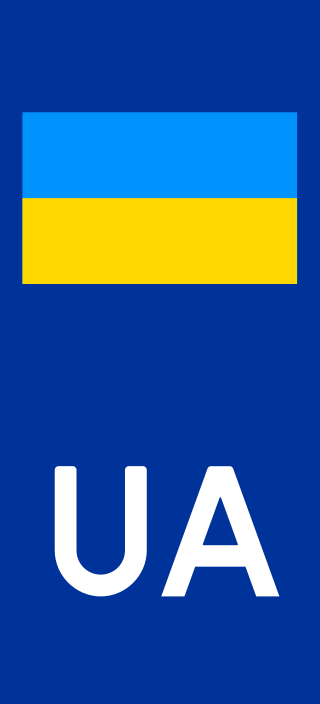
Since the restoration of Ukraine's independence in 1991, the country has used four main systems of vehicle registration plates.
Vehicle registration plates of Estonia are divided into 18 categories, the most common of these (A1) is composed of three numbers and three letters. Most registration plate types have black letters on a white background, and the plates are the same size and length as other European plates. Previously the first of the three letters indicated the region of Estonia in which the car was registered; however, as of 2013, this is no longer the case. The third digit from the numbers indicated states when the car is due an inspection. It can be inspected up to 2 months after that digit. The registration plates are printed on an aluminium sheet with minimum thickness of 1 mm and must fulfil the requirements of ISO 7591:1982. All plates are issued with the blue European Union identification label, except types A9 and B2.

Vehicle registration plates of Latvia consist of two letters, a hyphen and one to four numbers (depending on the age of registration), e.g., AB-1234,
Vehicle registration plates of Georgia are composed of an embossed serial of two letters, a hyphen, three numbers, a hyphen, and two letters, in black on a white background with a blue vertical strip on the left. The plates are issued in the Latin alphabet. Georgian registration plates are the same size as the most common European registration plate. All plates have the abbreviation "GE" in the lower left corner of the plate and the national flag in the upper left corner. This set of new style registration plates have been in use since 1 September 2014.
The vehicle registration plates of Cyprus are composed of three letters and three digits. A simple incremental numbering system is used; numbers run from 001 to 999 per letter sequence (alphabetic), so that, for example, the plate to be issued after MAA 999 would be MAB 001. However, registrants may be allowed to choose a number from available numbers in the extant letter sequence.
An Israeli vehicle registration plate, or an Israeli license plate, is a vehicle registration plate, a metal or plastic plate or plates attached to a motor vehicle or trailer, used in Israel for official identification purposes.
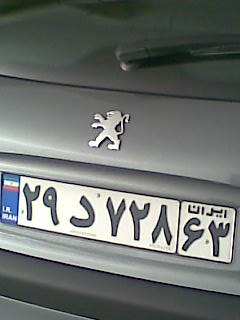
Iranian license plates have had European standard dimensions since 2005. Each province in Iran has multiple unique, two-digit codes that are included at the right end of the license plates in a distinguished square outline, above which the word ایران or "Iran" has been written. A province's license plates will not be issued with a new code unless all possible combinations with the old code have been issued. In Tehran, the first code to be issued for the province was code 11, and subsequent codes all increased by 11 as well Ever since code 99 was fully issued, the new codes for Tehran have started from 10 and subsequently increased by 10. Most province codes increased by 10 based on the first code issued for their province. Khuzestan Province, for example, has been allocated codes 24 and 14, and code 24 will not be used before code 14 is fully issued. However, as codes started getting exhausted, numbers and letters have been assigned more liberally and without following this rule of thumb anymore
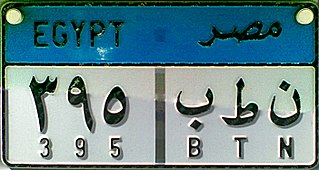
Egyptian vehicle registration number plates are used for official identification purposes for motor vehicles in Egypt. The international vehicle registration code for Egypt is EG.
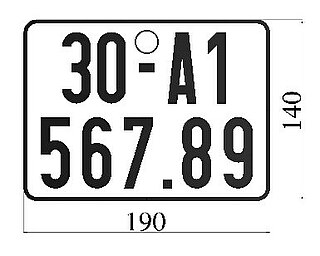
Vehicle registration plates of Vietnam generally take the form DDLL-DDD.DD for vehicles. Standard license plates have black characters on white background. Front plates measure 47 × 11 cm, rear ones are 27 × 20. In 2020 and 2021, both plates measure 6 x 12. The current scheme for civilian vehicles omits the letters I, J, O, Q and W, with the letter R reserved for trailers, and includes the Vietnamese character Đ.

Vehicle registration plates of Saudi Arabia are manufactured by the Government Printing Press in Riyadh. Saudi Arabia has taken action to ensure that all people residing within its borders register their vehicles in Saudi Arabia and display a rear as well as a front license plate.

Eritrea requires its residents to register their motor vehicles and display vehicle registration plates.
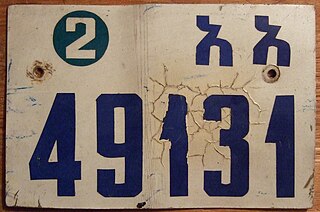
Ethiopia requires its residents to register their motor vehicles and display vehicle registration plates. Current plates feature Ge'ez text.

Libya requires its residents to register their motor vehicles and display vehicle registration plates. Current plates are European standard 520 mm × 110 mm.